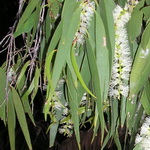| Common Name: |
Weeping Tea Tree |
| Other Names: |
Weeping Paperbark, cajuput |
| Botanical Name: |
Melaleuca leucadendra |
| Genus: |
Melaleuca |
| Family: |
Myrtaceae |
| Native Location: |
Indonesia, Papua New Guinea, and the Moluccas to N and W Australia |
| Cultivation: |
Moisture-retentive to wet, neutral to acid soil in sun; M. leucadendra tolerates light to saline soils. Pinch out young, pot growing plants to induce bushiness. |
| Propagation: |
By seed sown in spring at 13-24°C (55-75°F); by semi-ripe cuttings in summer. |
| Harvest: |
Oil is distilled from leaves and twigs, used directly, or in spirits and ointments. |
| Height: |
10m (30ft) |
| Width: |
Variable |
| Hardiness: |
Min. 15-18°C (59-64°F) |
| Parts Used: |
Oil |
| Properties: |
A stimulant, antiseptic herb with a strong, camphoraceous aroma. It is expectorant, relieves spasms, increases perspiration, and expels intestinal parasites. |
| Medicinal Uses: |
Internally for bronchitis, tuberculosis, colds, sinusitis, gastric infections, and roundworms. Contraindicated during pregnancy. Externally for rheumatism, gout, neuralgia, acne, nasal congestion, sinusitis, toothache, chilblains, and skin diseases. An antiseptic and painkiller in aromatherapy. |
| Economic Uses: |
Oil is used in perfumery, detergents, soaps, and insect-repellents. |
| Warning: |
Subject to legal restrictions in some countries, in the form of cajuput oil. |
| Bibliography: |
The Encyclopedia of Herbs by Deni Bown Copyright © 1995, 2001 Dorling Kindersley Limited. Pg. 273 |

